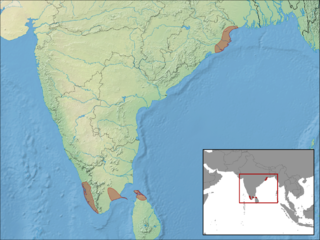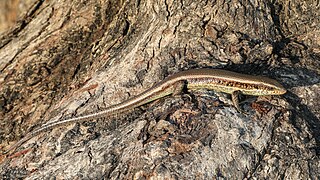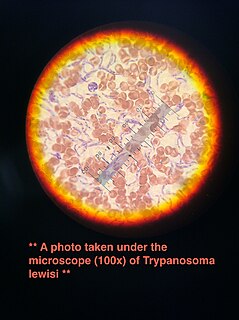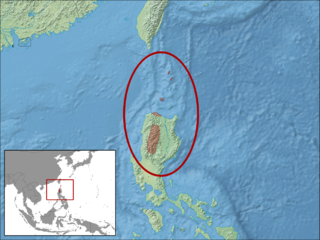
Camarasaurus was a genus of quadrupedal, herbivorous dinosaurs and is the most common North American sauropod fossil. Its fossil remains have been found in the Morrison Formation, dating to the Late Jurassic epoch, between 155 and 145 million years ago.

The blue iguana, also known as the Grand Cayman ground iguana, Grand Cayman blue iguana or Cayman Island rock iguana, is an endangered species of lizard which is endemic to the island of Grand Cayman. It was previously considered to be a subspecies of the Cuban iguana, Cyclura nubila, but in a 2004 article Frederic J. Burton reclassified it as a separate species because according to him the genetic differences discovered four years earlier between the different C. nubila populations warranted this interpretation. The blue iguana is one of the longest-living species of lizard.
Eutropis ashwamedhi, also known commonly as the Ashwamedh supple skink or Ashwamedha writhing skink, is a species of lizard in the family Scincidae. The species is endemic to India.

Eutropis bibronii, also known commonly as Bibron's mabuya, Bibron's skink, and the seashore skink, is a species of lizard in the family Scincidae. The species is native to India and Sri Lanka.
Eutropis dawsoni, also known commonly as Gans's grass skink and Gans's mabuya, is a species of lizard in the family Scincidae. The species is endemic to the southern Western Ghats, India.

The bronze grass skink, bronze mabuya or speckled forest skink, is a species of skink found in South and Southeast Asia. It is a common, but shy, ground-dwelling species that is active both day and night.

Eutropis multifasciata, commonly known as the East Indian brown mabuya, many-lined sun skink, many-striped skink, common sun skink or (ambiguously) as golden skink, is a species of skink.

Eutropis rugifera, variously known as Nicobar Island skink or rough-scaled sun skink, is a species of skink from southeastern Asia.

Camarasaurus lewisi is a species of sauropod dinosaur from the Upper Jurassic of the United States. It was named by James A. Jensen in 1988. C. lewisi was originally placed in its own genus, Cathetosaurus, but in 1996 it was reclassified as a species of Camarasaurus; most researchers since have considered it to be one of the four valid species of Camarasaurus. Two unpublished studies have since argued that the genus Cathetosaurus should be reinstated, whereas two other studies have argued that C. lewisi may be a junior synonym of another species of Camarasaurus.

The westslope cutthroat trout, also known as the black-spotted trout, common cutthroat trout and red-throated trout is a subspecies of the cutthroat trout and is a freshwater fish in the salmon family of order Salmoniformes. The cutthroat is the Montana state fish. This subspecies is a species of concern in its Montana and British Columbia ranges and is considered threatened in its native range in Alberta.
Lewis's tuco-tuco is a species of rodent in the family Ctenomyidae. It is endemic to Bolivia.

Chenoprosopus is a genus of extinct cochleosauridae that lived during late Carboniferous and early Permian periods. Two known species of Chenoprosopus are C. milleri and C. lewisi. Chenoprosopus lewisi was described in the basis of a virtually complete skull with maximum skull length of 95 mm. It is significantly smaller than Chenoprosopus milleri and was differentiated from that taxon by Hook (1993) based on sutural patterns of the skull roof. Hook also mentioned the reduced size of the vomerine tusks differentiated C. lewisi from C. milleri, but the different size of these tusks may be different ontogenetic stages of growth. Many of other cochleosaurids from the same time period have an elongated vomer and wide and elongate choana. However, Chenoprosopus is distinguished by its more narrowly pointed snout and separation between the nasal from the maxilla by the broad lacrimal-septomaxilla contact.

Eutropis is a genus of skinks belonging to the subfamily Mabuyinae. For long, this genus was included in the "wastebin taxon" Mabuya; it contains the Asian mabuyas. They often share their habitat with the related common skinks (Sphenomorphus), but they do not compete significantly as their ecological niches differ. This genus also contains the only member of the subfamily to occur in Australasia, the many-lined sun skink, whose wide range includes New Guinea.

Trypanosoma lewisi is a globally distributed parasite of Rattus species and other rodents such as mice, and of kangaroo rats in America. Among these host species were two endemic species of rats: Rattus macleari and Rattus nativitatis. Both are now believed to be extinct. It is not very clear whether or not the same parasite infected both species. However, both parasites are very similar. The northern rat flea acts as the vector for the parasite, harboring the epimastigote stage in its midgut. The trypomastigote is the stage that is present in the main host, the rodent. The epimastigote form attaches itself to the rectum of the insect using its flagella to burrow through the rectal walls. The parasites also appear in the flea's feces. Ingestion of either the flea or its feces during grooming infects the host rodent with the parasites. T. lewisi is normally non-pathogenic but is known to have produced fatal infections in rats.

Eutropis longicaudata, the longtail mabuya or long-tailed sun skink, is a species of skink. It is found in southern China, Hong Kong, Taiwan, Laos, Vietnam, Thailand, Cambodia, and Peninsular Malaysia.
Eutropis madaraszi, also known commonly as the Sri Lanka bronze mabuya, the Sri Lanka bronze skink, or (ambiguously) the spotted skink, is a species of lizard in the family Scincidae. The species is endemic to the island of Sri Lanka.
Eutropis austini is a species of skink, a lizard in the family Scincidae. The species is endemic to Sri Lanka.

The Luzon montane mabouya is a species of skink found in Luzon in the Philippines.
Eutropis borealis is a species of skink. Before being elevated to full-species rank in 2020, it was considered a subspecies of Eutropis multicarinata.













